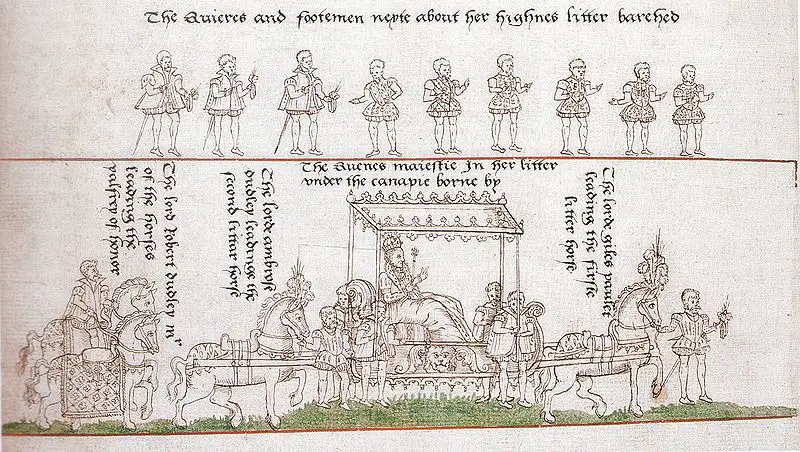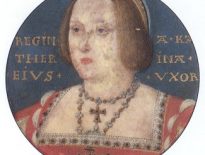8 January
1499 – Marriage of Louis XII and Anne of Brittany, widow of Charles VIII of France and the Queen Dowager. The couple had two surviving children: Claude, Queen of France, and Renée, Duchess of Ferrara.
1543 – Burial of King James V of Scotland at Holyrood Abbey, Edinburgh.
1570 – Death of Henry Clifford, 2nd Earl of Cumberland, at Brougham Castle. He was buried at Holy Trinity Church, Skipton. Clifford's career included serving Henry Fitzroy, Duke of Richmond, at Pontefract Castle, being made Knight of the Bath at the coronation of Anne Boleyn, serving as Carver to Henry VIII in 1540, and being appointed to the Council of the Borders and the Council of the North. He was married to Henry VIII's niece, Eleanor Brandon.
1571 – Burial of Mary Shelton (married names: Heveningham and Appleyard) at Heveningham Church, Suffolk. Mary was the daughter of Sir John Shelton and his wife Anne (née Boleyn), and wife of Sir Anthony Heveningham, then Philip Appleyard. Mary served Queen Anne Boleyn as one of her ladies.
1586 – Death of Sir George Seton, 5th Lord Seton, politician, Scottish nobleman and loyal supporter of Mary, Queen of Scots. He was a member of Mary's privy council. Seton was buried in Seton Church, East Lothian.
1594 – Death of Sir Wolstan Dixie, merchant and Lord Mayor of London, in London. He was buried at the parish church of St Michael Bassishaw. Dixie served as Lord Mayor of London in 1585-1586.
9 January
1514 - Anne of Brittany, wife of Louis XII of France, died at the Chateau of Blois. She was buried in the Cathedral Basilica of Saint-Denis.
1522 – Adriaan Florenszoon Boeyens was elected as Pope, becoming Pope Adrian VI.
1554 – Birth of Pope Gregory XV, born as Alessandro Ludovisi, in Bologna, Italy.
1539 – Executions of Henry Pole, 1st Baron Montagu, and Henry Courtenay, Marquis of Exeter, on Tower Hill. They were found guilty of high treason in December 1538 for denying the King's supremacy, desiring the King's death and favouring and promoting Cardinal Reginald Pole, Montagu's brother, “in his traitorous proceedings”.
1587 – Death of Clement Adams, schoolmaster and map engraver. He was buried at St Alfege, Greenwich. Adams is known for his re-engraving and re-working of Sebastian Cabot's “World Chart” 1544, which he did in 1549. Adams' chart was responsible for England focusing on the Northeast Passage, rather than the Northwest Passage. In 1552, Adams was given a life appointment as schoolmaster to the King's henchmen.
10 January
1480 - Margaret of Austria (Princess of Asturias and Duchess of Savoy) was born to her parents, Maximilian of Austria and Mary of Burgundy.
1514 – Completion and printing of the first section of the “Complutensian NewTestament” in Hebrew, Aramaic, Greek and Latin at Alcala, Spain.
1532 – Probable date of the burning of Thomas Dusgate, Protestant martyr, at Liverydole in Heavitree, near Exeter.
1603 – Probable date of death of Arthur Dent, religious writer and Church of England clergyman, from a fever. Dent's works included his “Sermon of Repentance”, “The Plaine-Mans Pathway to Heaven” and “The Ruine of Rome, or, An Exposition upon the Whole Revelation”.
11 January
1503 - Birth of painter Francesco Mazzuoli Parmigiano in Parma, Italy.
1564 – Death of Sir Richard Southwell, the Tudor administrator who had served Henry VIII, Edward VI and Mary I. He was buried in the chancel of Woodrising Church, Norfolk.
1569 - The first recorded lottery, “a verie rich Lotterie Generall”, was drawn at the west door of St Paul's Cathedral. Its purpose was to raise funds for the “reparation of the havens and strength of the Realme, and towardes such other publique good workes”.
1579 – Burial of George Ferrers, courtier, Member of Parliament, Lord of Misrule and poet, at Flamstead, Hertfordshire. Ferrers is known for the Ferrer's Case, when Ferrers was arrested for debt and fought with the arresting officers. Ferrers contributed works to “A Mirror for Magistrates”.
1584 – The Execution of William Carter, printer. He was hanged, drawn and quartered at Tyburn after being found guilty of treason, for printing a book which allegedly contained a passage inciting the assassination of Elizabeth I.
1591 - Birth of Robert Devereux, 3rd Earl of Essex, son of Elizabeth I's favourite, Robert Devereux, 2nd Earl of Essex. His maternal grandfather was Sir Francis Walsingham. Devereux was Captain-General of the parliamentary forces in 1642, and Lord-General in 1643.
12 January
1510 - Henry VIII jousted for the first time as king at a private joust at Richmond Park. His good friend William Compton was seriously hurt but survived.
1519 – Death of Maximilian I, Holy Roman Emperor, in Wels, Upper Austria. He was buried in the Castle Chapel at Wiener Neustadt, but visitors to the Hofkirche Court Church in Innsbruck can see a cenotaph tomb for Maximilian there because the church was built in memory of Maximilian by his grandson, Ferdinand I.
1539 - Francis I of France and Charles V, Holy Roman Emperor, signed the Peace of Toledo, agreeing to make no other alliances without the consent of the other.
1547 - Thomas Howard, 3rd Duke of Norfolk, who was imprisoned in the Tower of London, tried to save himself from execution by signing a confession.
1559 – Elizabeth I travelled to the Tower of London to prepare for her coronation, which was scheduled for the 15th January.
1560 – Death of John White, Bishop of Winchester, in South Warnborough. He was buried in Winchester Cathedral. White was a Catholic, was imprisoned in the Tower of London and deprived of his bishopric after the accession of Elizabeth I.
1573 – Death of William Howard, 1st Baron Howard of Effingham, soldier and naval commander, at Hampton Court. He was buried at Reigate Church. Howard was the fourth son of Thomas Howard, 2nd Duke of Norfolk, and his second wife, Agnes Tilney.
1577 – Death of Thomas Fisher (also known as Hawkins), landowner and MP. The first record of Fisher shows him serving John Dudley, who was then Viscount Lisle, but by 1544 he was working for Edward Seymour, Earl of Hertford. In Mary I's reign, he served as a Justice of the Peace and member of Parliament. He was buried in St Mary's Church, Warwick, in a tomb with his first wife, Winifred.
1587 – Death of Matthew Godwin, Organist and Choirmaster at the Cathedral Churches of Canterbury, then Exeter.
13 January
1547 - Henry Howard, Earl of Surrey, poet and soldier, was sentenced to death. He was tried in front of a common inquest at Guildhall, and despite pleading 'not guilty' and defending himself vigorously, he was found guilty.
1563 – Birth of Mark Alexander Boyd, poet and humanist scholar, in Ayrshire, Scotland. His works included the collections Epistolae quindecim and Epistolae heroides et hymni, and his famous Scots sonnet “Fra banc to banc”.
1584- Death of Thomas Wentworth, 2nd Baron Wentworth and de jure 7th Baron Le Despenser, soldier and administrator, at Stepney. Wentworth served Mary I as Lord Deputy of Calais, and was the one in charge when Calais fell to the French in January 1558.
1592 – Death of Sir Henry Brooke, courtier and diplomat, at Sutton-at-Hone. Although he was not Baron Cobham himself - that title belonged to his father then brother - he used Cobham as his surname. He served Elizabeth I as an ambassador in Spain, the Low Countries and France, and was the resident ambassador in France from October 1579 to September 1583.
1593 – Death of Sir Henry Neville, Groom of Henry VIII's Privy Chamber. He was buried at Waltham St Lawrence in Berkshire.
1599 – Death of Edmund Spenser, poet and administrator in Ireland. He died in Westminster and was buried in Westminster Abbey. Spenser is best known for his allegorical poem “The Faerie Queene”, which was dedicated to Elizabeth I.
1602 – Death of Sir John Forster, soldier and Warden of the Middle Marches, at Spindlestone, Northumberland. He was buried at Bamburgh parish church.
1612 – Death of Jane Suárez de Figueroa (née Dormer), Duchess of Feria. She was buried in the monastery of Santa Clara at Zafra, Spain.
1613 – Death of Edward Gresham, astrologer, astronomer, mathematician, magician and writer of the treatise “Astrostereon”. He died in London and was buried at All Saints-the-Less.
1628 – Death of Sir Anthony Ashley, Baronet, translator and politician, at Holborn House. He was buried at Wimborne St Giles in Dorset. Ashley published an English edition of Lucas Waghenaer's nautical charts, which he adapted and added to with accounts of Sir Francis Drake's 1587 raid on Cadiz and, of course, the 1588 Spanish Armada. It was published as “The Mariners Mirrour”.
14 January
1478 – Birth of Henry Algernon Percy, 5th Earl of Northumberland. He was the eldest son of Henry Percy, 4th Earl of Northumberland, and Maud Herbert, daughter of William Herbert, 1st Earl of Pembroke.
1515 – Charles Brandon, Duke of Suffolk, was sent to France to bring back Henry VIII's sister, Mary Tudor, Queen of France. The couple later married in secret before returning to England.
1526 – Francis I and Charles V signed the Treaty of Madrid. Francis I had been captured at the Battle of Pavia, and was held until this treaty was concluded. By the terms of the treaty, Francis renounced his claims to lands in Italy, Flanders, Artois and Tournai. Once he was released and back in France, Francis refused to ratify the treaty.
1559 - Elizabeth I's eve of coronation procession from the Tower of London to Westminster. Click here for more on this.
1589 – Francis Kett, physician, was burned for heresy near Norwich Castle. He had claimed that “Christ is not God, but a good man as others be”. Kett was dragged to the stake “clothed in sackecloth” and went to his death “leaping and dauncing” and “clapping his hands”.









Leave a Reply